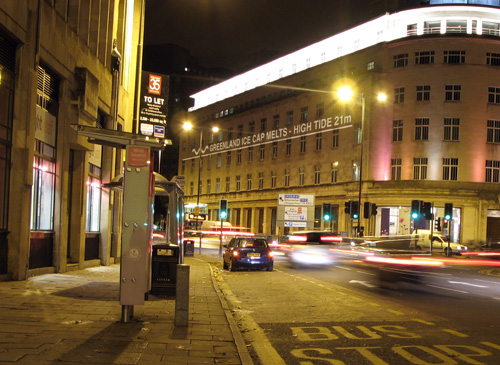Last night in Bristol, England, marked the start of Chris Bodle’s Watermarks Project. For the next week, Bodle will be projecting onto the facades of buildings throughout Bristol estimated future high-tide marks should the entire Greenland ice cap melt.
 [Image: From Chris Bodle’s Watermarks Project].
[Image: From Chris Bodle’s Watermarks Project].
The idea is brilliant; I love the idea of mapping the future earth onto the earth of the present, of overlaying onto our present geography the virtual presence of a geography yet to come.
In many ways, I’d even say that this project can be divorced from its immediate context of climate change science and applied to any number of terrestrial processes, from the projected future and the hypothesized past. Whether mapping lost lakes of a different era or tracing the edges of disappeared lagoons that still haunt the streets of San Francisco – or reminding urbanites of the sport-fishing possibilities beneath Manhattan – we are alive within laminations we will never fully map or comprehend.
And these geographic superimpositions needn’t all by hydrological: the constant erasures and revisions of the earth through plate tectonics represent an unlimited supply of counter-landscapes we might explore.
I’m reminded of John McPhee’s fantastic book Assembling California – part of his equally great collection Annals of the Former World. There, McPhee describes how entire “Newfoundlands, Madagascars, New Zealands, Sumatras, [and] Japans” have all come together, rammed into place, one into the other over millions of years, to form what we now call California. Walking around Los Angeles, or through the coastal hills of Bug Sur, you’re not walking on unified ground at all, then, but across “the metamorphosed remains of what had once been an island arc.”
The ground here is all wandering, nomadic wreckage, only it’s been temporarily “consolidated as California,” McPhee writes.
So could all those old islands be flagged, their mutated and compressed remains – sheer gravel, lone hillsides, folded slopes, and whole mountain ranges – marked out with surveyors’ tape? The Archipelago Project. You cross and recross lost geographies made visible through an artist’s intervention – or follow a new state hiking path that meanders around the edges of minor fault lines yet to open.
 [Image: From Chris Bodle’s Watermarks Project].
[Image: From Chris Bodle’s Watermarks Project].
In any case, projecting the earth’s future oceans onto a contemporary cityscape is an almost unbelievably stimulating idea.
These are the data points of a world yet to come, you might say, made visible here on the fronts of a hundred buildings – a future or alternative version of the earth coming into focus all around us.
(Via the RSA’s Arts & Ecology site, thanks to Nicky!)